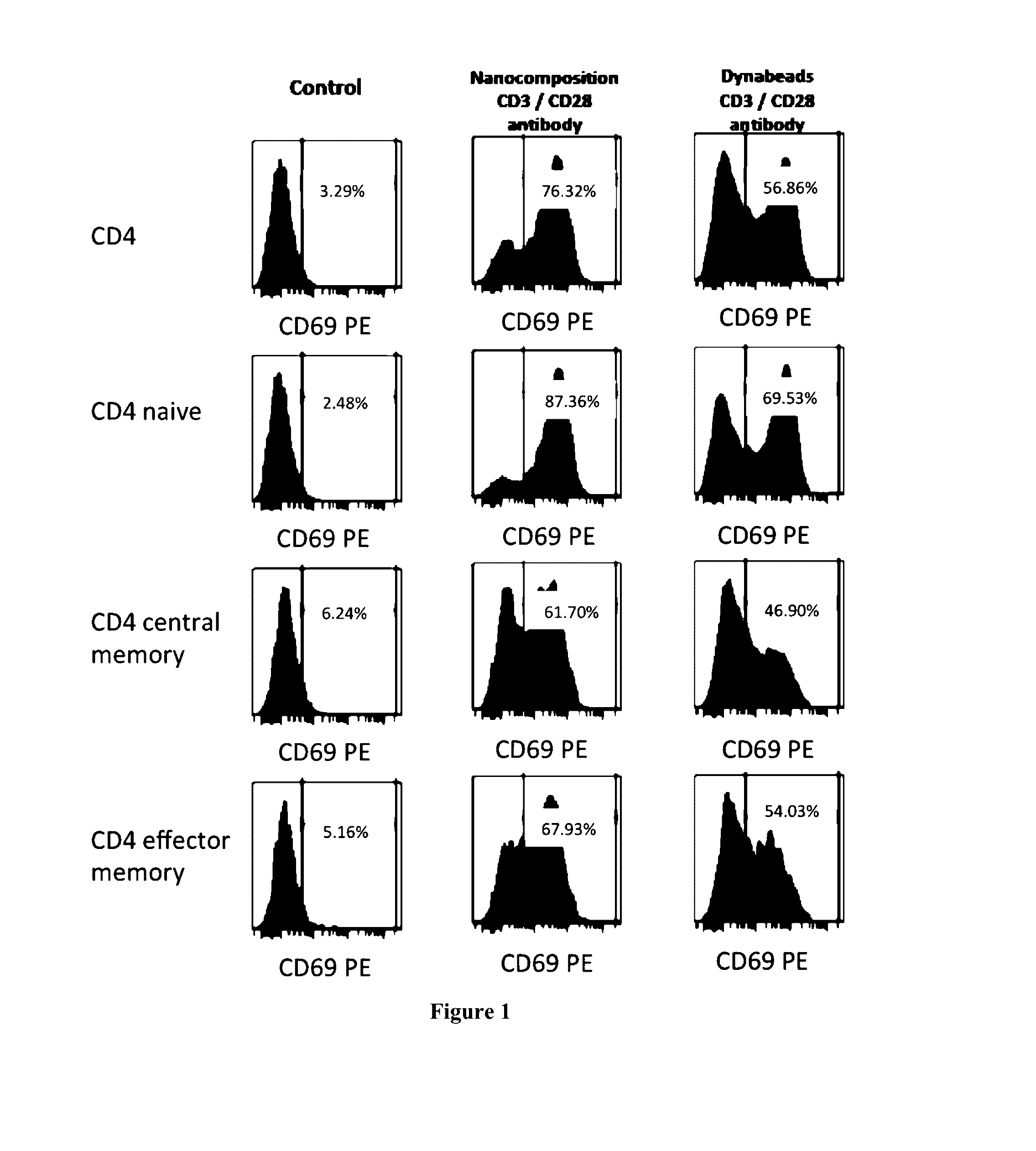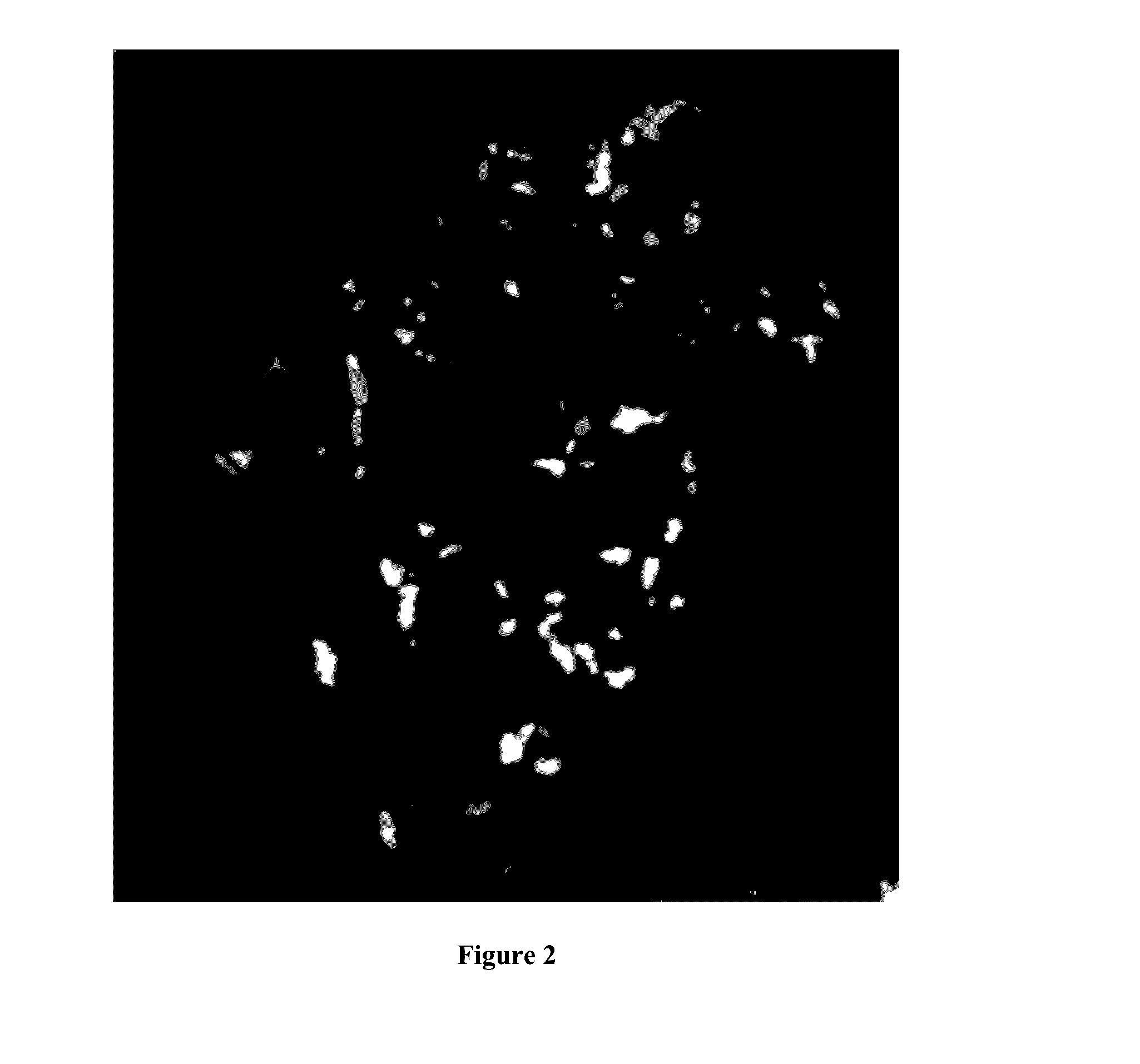Cell modulation nanocomposition, and methods of use
a cell behavior and nanocomposition technology, applied in the field of cell behavior modulation nanocomposition, can solve the problems of limited current strategies and approaches to modulating cell behavior, and achieve the effect of improving cell behavior and reducing the risk of infection
- Summary
- Abstract
- Description
- Claims
- Application Information
AI Technical Summary
Benefits of technology
Problems solved by technology
Method used
Image
Examples
example 1
Preparation of Nanocompositions
[0121]Nanocompositions were prepared with superparamagnetic iron oxide nanoparticles with silanization encapsulation. Final concentration of nanocomposition was adjusted to be 1 mg / ml. 0.3 mg / ml of streptavidin molecules were covalently conjugated to nanocomposition through a crosslinker Sulfo-SMCC, after overnight incubation, nanocomposition-streptavidin conjugates were purified from the rest of the solution by magnetic separation.
[0122]Anti-CD3 (Clone OKT3), anti-CD28 (Clone28.2), or other costimulating antibodies were biotinlyated first following suggested protocol using commercial biotinylation kit (Thermo Scientific). The purified biotinylated-antibodies were mixed with streptavidin-nanocomposition at the defined antibody / nanocomposition quantity and react overnight, then magnetically purified to form the needed antibody-conjugated nanocompositions.
example 2
Expansion of T Cells Using Anti-CD3 / Anti-CD28 Conjugated Nanocompositions
[0123]It has been reported that immobilized anti-CD3 and anti-CD28 antibodies can simultaneously deliver a signal and a co-stimulatory signal to stimulate proliferation of T cells (Baroja et al (1989), Cellular Immunology, 120: 205-217). In WO09429436A1 solid phase surfaces such as culture dishes and beads are used to immobilize the anti-CD3 and anti-CD28 antibodies. Regularly, the immobilization on beads is performed on DynaBeads®M-450 having a size of 4.5 um in diameter.
[0124]US2008 / 0317724A1 discloses that the spatial presentation of signal molecules can dramatically affect the response of T cells to those signal molecules. For example, when anti-CD3 and anti-CD28 antibodies are placed on separate predefined regions of a substrate, T cells incubated on the substrate secrete different amounts of interleukin-2 and / or exhibit spikes in calcium, depending not only on the types but also on the spacing of these si...
example 3
Comparison of Nanocomposition to Dynabeads®
[0128]Streptavidin conjugated magnetic low density nanostructures at 1 mg / ml concentration were mixed with 1 ug / ml biotinylated anti-CD3 antibody and 10 ug / ml biotinylated anti-CD28 antibody to prepare anti-CD3 / anti-CD28 conjugated nanocomposition. Anti-CD3 antibody were added to the nanostructure first and incubated for 30 min, subsequently anti-CD28 antibodies were added and the solution was left on a rotator at 4° C. overnight. On the next day, nanostructure-anti CD3 / CD28 antibody conjugates were purified from the rest of solution using magnetic separation, and redispersed in PBS buffer, ready to use. Fresh human PBMC without purification were adjusted to 106 cells / ml. 50 ul of 1 mg / ml of anti-CD3 / anti-CD28 conjugated nanocomposition were added to the cells. Dynabeads® (Life Technologies) were used following its protocol at 1:1 beads / T cells ratio. Used 25 ul washed beads / ml of 106 T cells.
[0129]As shown in FIG. 2 and Table 5, anti-CD3 / a...
PUM
| Property | Measurement | Unit |
|---|---|---|
| diameter | aaaaa | aaaaa |
| thickness | aaaaa | aaaaa |
| diameter | aaaaa | aaaaa |
Abstract
Description
Claims
Application Information
 Login to View More
Login to View More - R&D
- Intellectual Property
- Life Sciences
- Materials
- Tech Scout
- Unparalleled Data Quality
- Higher Quality Content
- 60% Fewer Hallucinations
Browse by: Latest US Patents, China's latest patents, Technical Efficacy Thesaurus, Application Domain, Technology Topic, Popular Technical Reports.
© 2025 PatSnap. All rights reserved.Legal|Privacy policy|Modern Slavery Act Transparency Statement|Sitemap|About US| Contact US: help@patsnap.com


